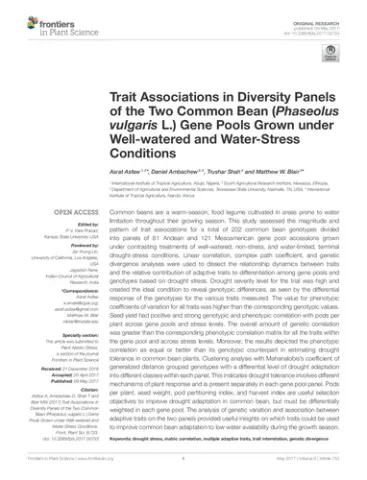Trait associations in diversity panels of the two common bean (Phaseolus vulgaris L.) gene pools grown under well-watered and water-stress conditions

Abstract
Common beans are a warm-season, food legume cultivated in areas prone to water limitation throughout their growing season. This study assessed the magnitude and pattern of trait associations for a total of 202 common bean genotypes divided into panels of 81 Andean and 121 Mesoamerican gene pool accessions grown under contrasting treatments of well-watered, non-stress, and water-limited, terminal drought-stress conditions. Linear correlation, complex path coefficient, and genetic divergence analyses were used to dissect the relationship dynamics between traits and the relative contribution of adaptive traits to differentiation among gene pools and genotypes based on drought stress. Drought severity level for the trial was high and created the ideal condition to reveal genotypic differences, as seen by the differential response of the genotypes for the various traits measured. The value for phenotypic coefficients of variation for all traits was higher than the corresponding genotypic values. Seed yield had positive and strong genotypic and phenotypic correlation with pods per plant across gene pools and stress levels. The overall amount of genetic correlation was greater than the corresponding phenotypic correlation matrix for all the traits within the gene pool and across stress levels. Moreover, the results depicted the phenotypic correlation as equal or better than its genotypic counterpart in estimating drought tolerance in common bean plants. Clustering analysis with Mahanalobis's coefficient of generalized distance grouped genotypes with a differential level of drought adaptation into different classes within each panel. This indicates drought tolerance involves different mechanisms of plant response and is present separately in each gene pool panel. Pods per plant, seed weight, pod partitioning index, and harvest index are useful selection objectives to improve drought adaptation in common bean, but must be differentially weighted in each gene pool. The analysis of genetic variation and association between adaptive traits on the two panels provided useful insights on which traits could be used to improve common bean adaptation to low water availability during the growth season.
